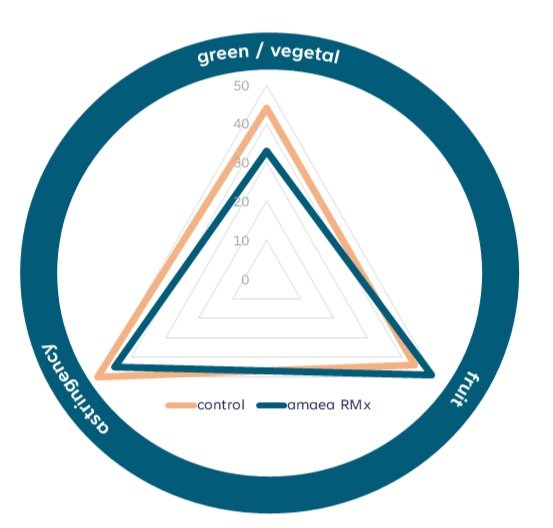Releasing green in Sonoma County
Californian winery remediates pyrazines from wine using amaea’s MIP technology
For the wine industry, every vintage is different. That’s what makes wine so interesting; you can experience changes from year to year and taste the differences within growing regions, depending on how the grapes responded to their environment. Winegrowers have ever more challenges to adapt to as climate change influences the timing and duration of the seasons.
In California, typical growing conditions allow time to ripen Cabernet Sauvignon grapes slowly and completely. The 2022 season was hot and contracted by a massive heat spike that lasted 10 days and stopped the ripening process altogether. In 2023 the harvest was long and cool, stalling the process. In 2022 and 2023, the weather led to lower alcohol and higher pyrazine concentrations, more specifically, IBMP (3-isobutyl-2-methoxypyrazine), in those wines.
IBMP a.k.a. the green, bell pepper, vegetal pyrazine, is the aroma that one typically experiences in wines made from grapes such as Cabernet Sauvignon, when the grapes have not had enough heat and light exposure to fully metabolize this naturally occurring compound.
We humans are very sensitive to the green aroma, so it can be distracting in a soothing sensory background of luscious ripe fruit and fermentation aromas. Pyrazines can hide fruit aromas in a Cabernet wine at low levels ranging from 2-5 ppt (parts-per-trillion).
Challenge
Winemakers looking to have more fruit-forward expressions in less-ripe red wines have very few options, especially in cooler vintages, where berry ripeness is limited. Masking the pyrazine with oak or blending with other lots that had more ripe fruit flavors is possible, but winemakers are limited to trying to integrate an aroma that is out of place in an otherwise balanced background.
Solution
A Californian winery recently used amaea RMx to remediate pyrazine levels from a 2022 Sonoma County Cabernet Sauvignon wine.
Instead of oak alternatives, enological tannins or inactivated yeast products to help mask the pyrazines earlier in the winemaking process, the wine was filtered using molecularly imprinted polymers (MIPs) – amaea’s reusable filtration media designed to selectively target the removal of pyrazines, with IBMP used as the analytical marker.
2,400 Liters of wine was treated in approximately three hours.
The treated wine was tasted by an employee panel of vineyard and winery workers during a technical winemaking meeting.
Results
Sensory
By reducing the concentration of pyrazines, it allowed more fruit aromas to shine through and dominate. The process used a low dose rate and high flow rate (a measure of the available capture sites and contact time of the wine with the MIPs) to remediate the green/vegetal aroma of the wine. The treatment removed 23% of IBMP (1.4 ppt) and had a significant sensory impact in a blind tasting (see Figure 1.).
Figure 1. Sensory results of 81 panelists tasting a 2022 Cabernet Sauvignon. Panelists noted decreased green/vegetal aromas along with increased fruit aromas. Astringency was also lessened by the treatment.
Product marketability
The winemaker used this lot as a portion of a larger blend. The resulting Cabernet Sauvignon wine had less green character, and the winemaker met their blending goals for the price tier and brand.
Operational gains
The winemaker saved days in this process by not having to design an alternative oak plan for the IBMP impacted wine. They called their service provider and scheduled the work. By treating the wine in less than a day, they could immediately work on blending. The convenience of scheduling, savings in time and the ability to customize the treatment made this process worthwhile operationally.
Treatment Summary
Wine varietal: 2022 Sonoma County Cabernet Sauvignon
Volume of wine processed: 2,400 L
Date of treatment: April 2024
Applied dose rate: 3.15 g/L
Applied flow rate: 90 CV/hr
Treatment conducted by: Sonoma, California Winery
amaea solution: amaea RMx
About the winery
The Sonoma County winery produces 1.1 million 9 Liter cases per year and makes four varietal wines under a single brand. The winemaker has been working in the industry for 22 years, having experienced harvest in Australia, New Zealand and California.


